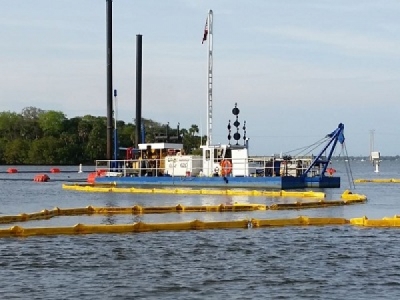
Posted on March 7, 2018
The Initial Project
At one time, over 4 million gallons (1,514 million liters) of toxic semi-treated sewage flowed into Palm Bay Florida’s Turkey Creek. As a result, Turkey Creek contained extremely high levels of harmful toxins and nutrients.
During the spring of 2017, the team from Gator Dredging spent most of their time focused on cleaning up the mess that once occupied Turkey Creek, removing over 236,000 yd3 (180,435 m3) of muck, nitrogen, and phosphorus contamination.
The Right Kind of Equipment
When working on a project the size of Turkey Creek, you need the right kind of equipment. For this project, an Ellicott Series 670 Dragon® dredgewas selected. The 670 is capable of digging as deep as 42 feet (13.0 m) and contains a sizeable pump with a lot of horsepower that’s needed to complete a job of this magnitude. The Series 670 Dragon® dredge is known as a dependable, reliable, and top-notch piece of machinery with an excellent reputation.
The initial Turkey Creek cleanup took several months to complete, but as the project was drawing to a close, all of the parties that were impacted by the initial cleanup thought that their work was nearly complete. However, little did they know that a natural disaster was just around the corner that would negate all of their prior hard work and effort.
Hurricane Irma
On September 11, 2017, Hurricane Irma hit the Gulf Coast of Florida, causing significant flooding in the nearby Turkey Creek community located close to Gainesville. For the second time in less than two years, the harmful muck that had previously existed in Turkey Creek once again infiltrated the body of water and had to be cleaned up. This time, the team from Gator Dredging was asked to remove organic muck that could now be found underneath docks located in shallow areas and filling deep holes throughout the surrounding Turkey Creek area that had been impacted by damage from the storm.
Two of the most significant challenges facing the team from Gator Dredge during the cleanup process this time included managing materials and controlling the return of water. That’s because, for nearly five decades, local and state officials ignored the condition of the creek, the impact that the muck had on the health of residents, and its impact on the surrounding habitat.
Why Dredging?
Dredging is the foundation of most aquatic projects and addresses a wide range of the world’s financial, social, and environmental needs. With more than 50 percent of the world’s population living inside of a 125 miles (201 km) radius of a significant coastline, low lying areas like Turkey Creek are in jeopardy of severe flooding and require constant improvements along and near its shoreline.
Aquatic areas similar to Turkey Creek have experienced rising water levels caused by powerful storms such as Hurricane Irma. The results include property damage for hundreds of homeowners impacted by deadly hurricanes, and it also affects the surrounding habitat causing millions of dollars in damage if left untreated.
So why is dredging important? When a body of water is dredged, there is a less likely chance of shore erosion occurring, and the surrounding habitat is restored. Several forms of sediment contain toxins from industrial runoff that significantly impact the water quality.
When any type of debris that contains pollutants are removed, the overall health of a body of water improves.
Source: Ellicott Dredges





